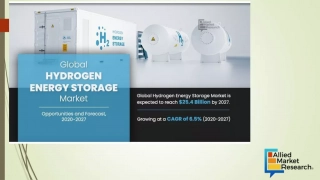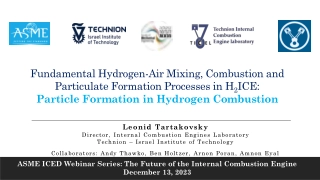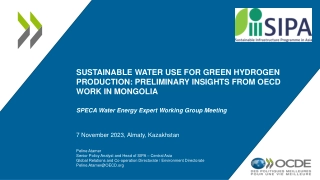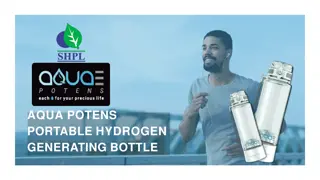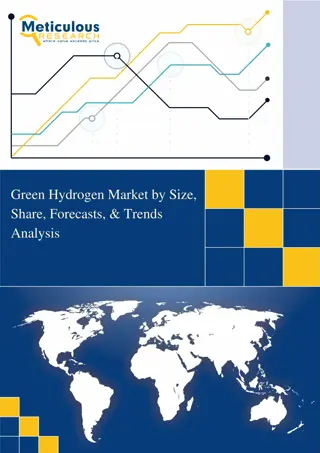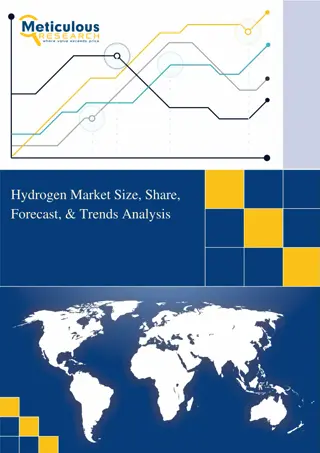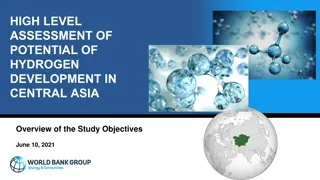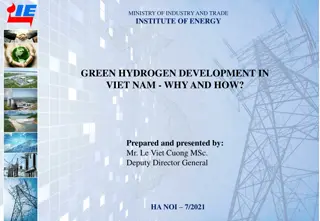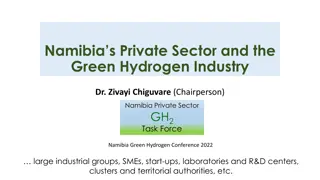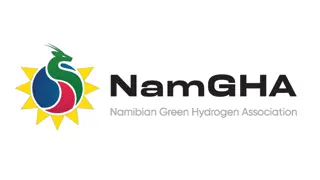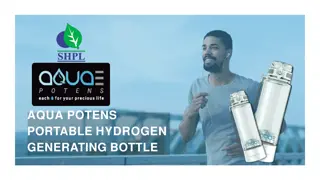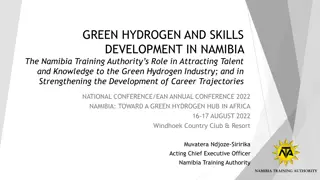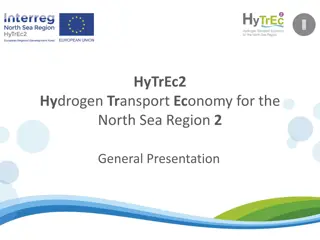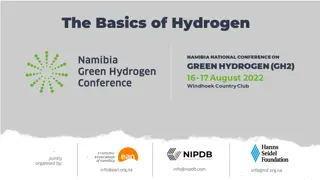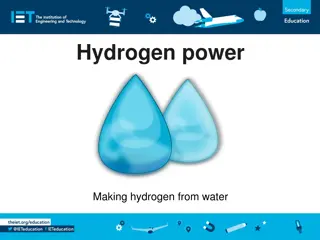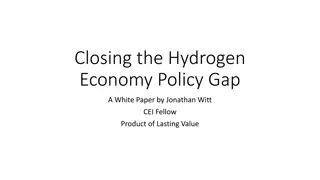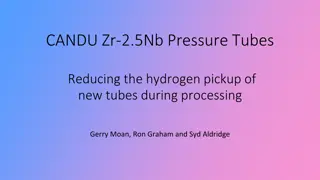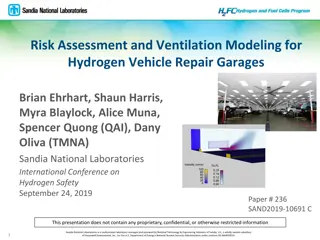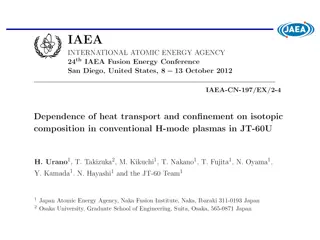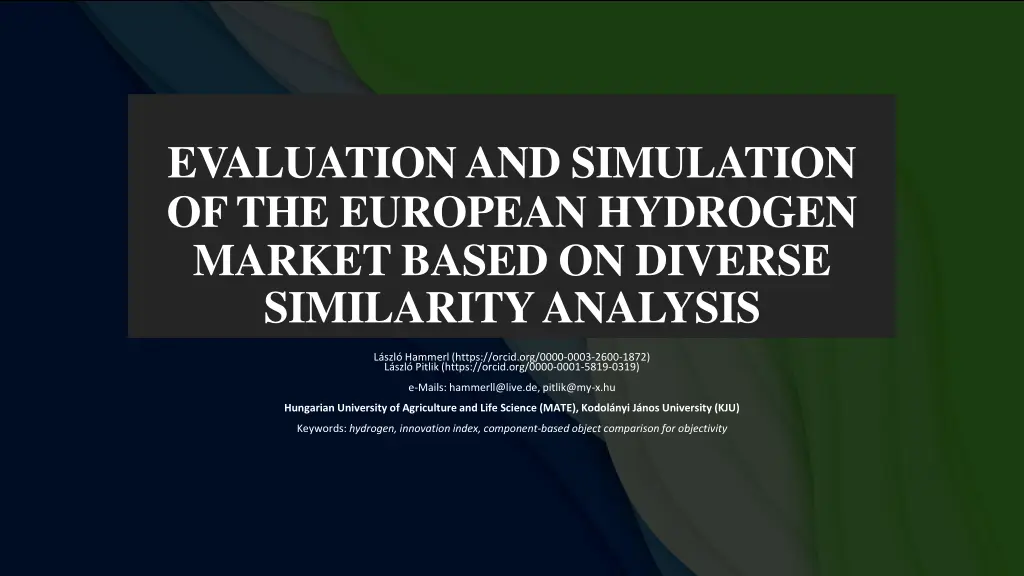
Evaluation and Simulation of the European Hydrogen Market Analysis
Explore the evaluation and simulation of the European hydrogen market based on diverse similarity analysis. This study identifies policy steps for hydrogen-powered mobility in Central Europe, focusing on sustainability and alternative fuels. Quantitative assessments reveal market inefficiencies, guided by a two-step analysis and COCO-Model adaptation methodology.
Download Presentation

Please find below an Image/Link to download the presentation.
The content on the website is provided AS IS for your information and personal use only. It may not be sold, licensed, or shared on other websites without obtaining consent from the author. If you encounter any issues during the download, it is possible that the publisher has removed the file from their server.
You are allowed to download the files provided on this website for personal or commercial use, subject to the condition that they are used lawfully. All files are the property of their respective owners.
The content on the website is provided AS IS for your information and personal use only. It may not be sold, licensed, or shared on other websites without obtaining consent from the author.
E N D
Presentation Transcript
EVALUATION AND SIMULATION OF THE EUROPEAN HYDROGEN MARKET BASED ON DIVERSE SIMILARITY ANALYSIS L szl Hammerl (https://orcid.org/0000-0003-2600-1872) L szl Pitlik(https://orcid.org/0000-0001-5819-0319) e-Mails: hammerll@live.de, pitlik@my-x.hu Hungarian University of Agricultureand Life Science (MATE), Kodol nyi J nos University (KJU) Keywords: hydrogen, innovation index, component-based object comparison for objectivity
Introduction Theoretical aim: Identify required policymaking steps for establishing hydrogen-powered individual mobility in Central Europe Why? Demand for sustainable progress Increased mobility desire -> alternative fuels for the automobile transportation sector Practical aim: Examine a quantitative performance assessment to expose the inefficiencies of countries with a high degree of market penetration and vice versa. Two-step analysis Define variables Define Model
Variables: Xi -> Y Variable Measuring unit per capita per 1000 inhabitants per 1000 inhabitants per 1 million inhabitants Expectation + + + + Gross public expenditure on R&D Number of passenger cars Number of passenger cars produced The number of hydrogen filling stations Hydrogen production capacity Tons per 1 million inhabitants + - Electricity prices for household consumers Share of zero-emission vehicles in newly registered passenger cars Purchasing Power Standard/KWh % + Percentage of alternative fuels (electric, hybrid, etc.) regarding all (+diesel and petrol) new truck registrations Petrol prices % + /l + Number of hydrogen cars Per 1 million inhabitants
Methodology Own adaptation COCO-Model : the underlying methodological aim is to the different data should allow us to recognise a certain trend. broad range of estimations and forecasts (regressions and averages to more complex neural networks)
Data overview- short Country Gross p. exp. on R&D Euro/capita 1449,9 1397,9 79,4 179,6 232,1 444,4 1621,7 414,2 1353,7 817,6 1357,1 246,8 260,1 1628,6 899,2 447,6 122,6 222,6 1165 184,1 1105,3 1489,6 218,1 346,2 59,4 50 168,2 529,6 363,9 1737,4 1988,372093 271,0843373 No. of cars produced number/ 1000 inhabitants 13,89 19,27 0,00 0,00 0,00 105,09 0,00 0,00 16,79 13,53 37,20 0,00 40,70 0,00 0,00 7,50 0,00 0,00 0,00 0,00 6,00 0,00 6,93 22,14 22,10 3,11 184,00 45,46 35,04 24,68 0,00 9,24 Number of vehicles number/ 1000 inhabitants 570 509 414 433 645 565 466 608 654 566 574 514 403 216 458 670 390 560 682 597 503 514 664 540 379 285,7142857 447 555 521 476 537 157 No. of H fuel stations per 1 m. inhabitants 0,447794745 0,259633102 0 0 0 0,095284957 1,027389344 0 0 0,280829616 1,070290023 0 0 0 0 0,016881565 0 0 0 0 0,400562733 0 0 0 0 0 0 0 0,063292882 0,289036972 0 0 Yearly H production capacity tons per 1 m. inhabitants 19,03 49,33 31,81 37,16 0,00 12,39 5,14 0,00 34,33 12,12 25,13 36,52 26,72 0,00 2,00 14,35 0,00 96,58 0,00 0,00 88,70 53,79 27,22 15,54 12,50 0,00 38,46 0,00 16,67 23,12 2,31 0,00 Electricity tariffs for consumers Purchasing Power Standard/KWh 0,1999 0,2684 0,2024 0,2029 0,2515 0,2502 0,2583 0,2417 0,1455 0,1858 0,2927 0,2386 0,1615 0,0921 0,2481 0,2376 0,2555 0,2166 0,1538 0,1493 0,1251 0,1479 0,2697 0,255 0,3097 0,1526 0,2017 0,2035 0,2999 0,2022 0,205 0,2747 Percentage of alt. trucks % 8,2 54,1 0 23,3 0 8,1 34,4 52,8 51,3 36,6 32 0 4,7 6,7 56,3 19,2 13 0 0 0 65,9 9,9 28,8 26,8 79,7 0 8,7 0 47,8 47,4 38,6 0 Petrol prices /liter 1,454 1,735 1,285 1,330 1,477 1,503 1,824 1,699 1,842 1,616 1,689 1,827 1,575 2,103 1,611 1,609 1,586 1,479 1,485 1,340 1,742 1,942 1,395 1,600 1,320 1,492 1,494 1,242 1,563 1,705 1,805 0,935 Share of 0-emission vehicles % 6,2 3,3 1,2 1,5 0,4 1,6 7 1,9 4,3 6,7 6,4 0,8 2,2 26,2 4,5 2,3 2,1 1,1 5,5 1,2 20,2 51,6 0,8 5,2 2,2 0 1,1 3,1 2,1 9,3 7,9 0,1 Number of hydrogen cars Per 1 million inhabitants 55 85 0 0 0 9 226 0 1 396 1236 0 0 27 0 45 0 0 3 0 488 231 74 3 0 0 2 0 19 63 200 0 Austria Belgium Bulgaria Croatia Cyprus Czech Republic Denmark Estonia Finland France Germany Greece Hungary Iceland Ireland Italy Latvia Lithuania Luxembourg Malta Netherlands Norway Poland Portugal Romania Serbia Slovakia Slovenia Spain Sweden Switzerland Turkey
Data ranking - long Country Gross p. expenditure on R&D No. of cars produced No. of vehicles No. of H fuel stations Yearly H production capacity Electricity tariffs % of alt. fuels trucks Petrol prices 0-emission cars Euro/capita no./ 1k inh. no./ 1k inh. per 1 m. inh. 10 6 3 12 27 7 7 10 13 30 11 19 14 27 11 19 23 23 11 19 22 16 8 2 26 4 2 19 20 17 11 19 3 9 11 11 9 13 6 13 30 8 1 5 19 22 11 19 8 21 11 4 1 3 11 19 21 12 11 19 18 15 10 15 25 29 11 19 17 24 11 19 7 10 11 19 5 26 11 19 2 11 4 17 4 5 11 19 28 25 11 16 24 19 11 8 32 31 11 9 6 32 11 18 11 28 11 1 15 14 11 3 31 18 9 6 12 2 5 7 16 1 11 19 29 20 11 14 tons per 1 m. inh. 9 19 26 25 5 11 22 6 4 10 8 17 27 31 23 2 28 12 1 7 20 17 3 14 29 30 24 13 16 21 15 32 PPS/KWh 20 4 24 15 24 21 11 5 6 10 12 24 23 22 3 16 17 24 24 24 2 18 13 14 1 24 19 24 7 8 9 24 % 25 8 30 28 24 19 5 10 3 12 11 4 17 1 13 14 16 23 22 27 7 2 26 15 29 21 20 31 18 9 6 32 /liter 9 14 24 23 30 22 6 21 13 7 8 28 17 2 12 16 19 26 10 24 3 1 28 11 17 32 26 15 19 4 5 31 % 14 4 9 6 24 19 21 24 8 20 12 7 11 24 23 17 24 1 24 24 2 3 10 16 18 24 5 24 15 13 22 24 Austria Belgium Bulgaria Croatia Cyprus Czech Republic Denmark Estonia Finland France Germany Greece Hungary Iceland Ireland Italy Latvia Lithuania Luxembourg Malta Netherlands Norway Poland Portugal Romania Serbia Slovakia Slovenia Spain Sweden Switzerland Turkey
Short detour -1:into production functions # Coco Gross p. expenditure on R&D Yearly H production capacity No. of cars produced No. of H fuel stations % of alt. fuels trucks Variables No. of vehicles Electricity tariffs Petrol prices 0-emission cars direction 0 0 0 0 0 1 0 0 0 Correlation(Y vs Xi) 0,650169683 -0,186703081 -0,28185803 0,312085444 0,061352824 -0,433312636 0,041491579 0,657139708 0,767716926 Data -> https://miau.my-x.hu/myx-free/coco/beker_std.php Delta/Fact Validity 1,00 correction inverz delta 4074,8 country Austria Hydrogen car market Delta/Fact -6,66 there could have been more sales Relatively high number of sales compared to potential there could have been more sales there could have been more sales Relatively high number of sales compared to potential there could have been more sales -6,66 1,00 -15945,7 Bulgaria 2,73 2,73 1,00 1,00 356,3 9339,9 Finland Germany -5,64 -38,74 -5,64 -38,74 1,00 -12,4 Poland 19,52 19,52 0,00 -80,9 Sweden -45,62 -45,62 1,00
Short detour -2: naive estimations Non-optimized solution: approximately guess which country or countries are the "best" based on these rankings in an aggregated way . -> Dilemma of personal preferences or interests not everyone values the same attributes/directions in a subjective Learning: The best modelling approach is the approach, which is capable of deriving the most robust (objectively close) approximations compared to the facts (in the future).
Coco results innovation diffusion index Direction [ ] 0 Variables [ ] Number of hydrogen cars Y0 Estimate validity Country order Naive average Naive average Difference 14 4 9 6 24 19 21 24 8 20 8 7 1000000 1000000 1000000 1000000 1000000 1000000 1000000 1000000 1000000 1000000 1000049,3 1000051,3 999922,8 999941,8 999932,8 1000030,8 1000024,8 999983,8 1000065,3 1000041,3 1 1 1 1 1 1 1 1 1 1 Austria Belgium Bulgaria Croatia Cyprus Czech Republic Denmark Estonia Finland France 6 4 29 27 28 10 13 22 1 7 11,6 10,7 20,5 18,7 20,2 15,3 11,9 15,2 8,6 11 10 6 29 26 28 16 11 15 3 8 4 2 0 1 0 6 2 7 2 1 19 19 19 13 3 19 18 10 12 18 24 5 24 15 6 1000000 1000000 1000000 1000000 1000000 1000000 1000015,8 999989,3 999916,8 1000026,8 1000014,8 999947,8 1 1 1 1 1 1 Germany Romania Serbia Slovakia Slovenia Spain 16 21 31 12 17 26 10,1 19,6 21,7 16,1 16,9 15,4 5 27 31 20 21 17 11 6 0 8 4 9 19 19 16 19 15
COCO can illustrate Conclusion & future Europe's strategic missing-out in hydrogen-electric private mobility technological acceptance of a different propulsion in privately owned cars customer responsiveness the countries' potential under the status quo Each attribute can also be interpreted as dependent variable (Y). This multi-layered interpretation (incl. more years) will lead to an automated SWOT analyses and the elimination of statistical errors.
References https://newsroom.aaa.com/2022/12/nearly-113-million-people-will-travel-from- december-23-to-january-2/ https://miau.my-x.hu/miau/294/hydrogen_market_analyses_2023_abs.xlsx

